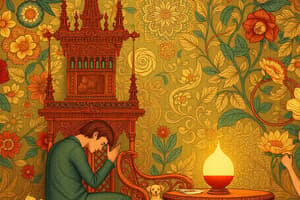Podcast
Questions and Answers
Match the following thinking skills with their primary characteristics:
Match the following thinking skills with their primary characteristics:
Analytical Thinking = Identifying biases, assumptions, and flaws in reasoning Critical Thinking = Generating new and original ideas or solutions Creative Thinking = Breaking down complex information into smaller parts Logical Thinking = Using reasoning and evidence to arrive at a conclusion
Match the following thinking skills with their primary applications:
Match the following thinking skills with their primary applications:
Logical Thinking = Developing innovative solutions, products, or services Lateral Thinking = Evaluating arguments, making decisions, and solving problems Creative Thinking = Analyzing data, identifying problems, and developing solutions Analytical Thinking = Generating novel solutions by thinking outside the box
Match the following thinking skills with their primary skills required:
Match the following thinking skills with their primary skills required:
Critical Thinking = Imagination, flexibility, and risk-taking Analytical Thinking = Active listening, skepticism, and open-mindedness Logical Thinking = Attention to detail, categorization, and organization Creative Thinking = Sequential thinking, pattern recognition, and deduction
Match the following thinking skills with their primary focus:
Match the following thinking skills with their primary focus:
Match the following thinking skills with their primary benefits:
Match the following thinking skills with their primary benefits:
Match the following thinking skills with their primary weaknesses:
Match the following thinking skills with their primary weaknesses:
Match the following thinking skills with their primary methods:
Match the following thinking skills with their primary methods:
Match the following thinking skills with their primary outcomes:
Match the following thinking skills with their primary outcomes:
Flashcards are hidden until you start studying
Study Notes
Thinking
Critical Thinking
- Objective analysis of information to form a judgment
- Involves identifying biases, assumptions, and flaws in reasoning
- Key skills: active listening, skepticism, and open-mindedness
- Used to evaluate information, arguments, and ideas
Creative Thinking
- Generating new and original ideas or solutions
- Involves making connections between seemingly unrelated concepts
- Key skills: imagination, flexibility, and risk-taking
- Used to develop innovative solutions, products, or services
Analytical Thinking
- Breaking down complex information into smaller parts to understand relationships
- Involves identifying patterns, causes, and effects
- Key skills: attention to detail, categorization, and organization
- Used to analyze data, identify problems, and develop solutions
Logical Thinking
- Using reasoning and evidence to arrive at a conclusion
- Involves using inductive and deductive reasoning
- Key skills: sequential thinking, pattern recognition, and deduction
- Used to evaluate arguments, make decisions, and solve problems
Lateral Thinking
- Generating novel solutions by thinking outside the box
- Involves finding unconventional connections between concepts
- Key skills: flexibility, creativity, and willingness to challenge assumptions
- Used to develop innovative solutions, products, or services
Abstract Thinking
- Thinking about concepts, ideas, and principles that are not physical
- Involves understanding relationships, patterns, and systems
- Key skills: conceptualization, visualization, and generalization
- Used to develop theories, models, and frameworks
Concrete Thinking
- Thinking about specific, tangible objects, events, or situations
- Involves focusing on details, facts, and sensory information
- Key skills: attention to detail, observation, and classification
- Used to understand and analyze real-world situations, objects, or events
Types of Thinking
Critical Thinking
- Critical thinking is an objective analysis of information to form a judgment
- It involves identifying biases, assumptions, and flaws in reasoning
- Key skills required for critical thinking are active listening, skepticism, and open-mindedness
- Critical thinking is used to evaluate information, arguments, and ideas
Creative Thinking
- Creative thinking generates new and original ideas or solutions
- It involves making connections between seemingly unrelated concepts
- Key skills required for creative thinking are imagination, flexibility, and risk-taking
- Creative thinking is used to develop innovative solutions, products, or services
Analytical Thinking
- Analytical thinking breaks down complex information into smaller parts to understand relationships
- It involves identifying patterns, causes, and effects
- Key skills required for analytical thinking are attention to detail, categorization, and organization
- Analytical thinking is used to analyze data, identify problems, and develop solutions
Logical Thinking
- Logical thinking uses reasoning and evidence to arrive at a conclusion
- It involves using inductive and deductive reasoning
- Key skills required for logical thinking are sequential thinking, pattern recognition, and deduction
- Logical thinking is used to evaluate arguments, make decisions, and solve problems
Lateral Thinking
- Lateral thinking generates novel solutions by thinking outside the box
- It involves finding unconventional connections between concepts
- Key skills required for lateral thinking are flexibility, creativity, and willingness to challenge assumptions
- Lateral thinking is used to develop innovative solutions, products, or services
Abstract Thinking
- Abstract thinking involves thinking about concepts, ideas, and principles that are not physical
- It involves understanding relationships, patterns, and systems
- Key skills required for abstract thinking are conceptualization, visualization, and generalization
- Abstract thinking is used to develop theories, models, and frameworks
Concrete Thinking
- Concrete thinking involves thinking about specific, tangible objects, events, or situations
- It involves focusing on details, facts, and sensory information
- Key skills required for concrete thinking are attention to detail, observation, and classification
- Concrete thinking is used to understand and analyze real-world situations, objects, or events
Studying That Suits You
Use AI to generate personalized quizzes and flashcards to suit your learning preferences.




